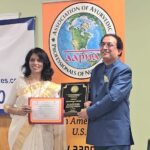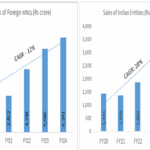healthy soch
New Delhi, September 21, 2019:
Oral polio vaccine (OPV) contains an attenuated (weakened) vaccine-virus, activating an immune response in the body. When a child is immunized with OPV, the weakened vaccine-virus replicates in the intestine for a limited period, thereby developing immunity by building up antibodies. During this time, the vaccine-virus is also excreted. In areas of inadequate sanitation, this excreted vaccine-virus can spread in the immediate community (and this can offer protection to other children through ‘passive’ immunization), before eventually dying out.
On rare occasions, if a population is seriously under-immunized, an excreted vaccine-virus can continue to circulate for an extended period of time. The longer it is allowed to survive, the more genetic changes it undergoes. In very rare instances, the vaccine-virus can genetically change into a form that can paralyse – this is what is known as a circulating vaccine-derived poliovirus (cVDPV).
It takes a long time for a cVDPV to occur. Generally, the strain will have been allowed to circulate in an un- or under-immunized population for a period of at least 12 months. Circulating VDPVs occur when routine or supplementary immunization activities (SIAs) are poorly conducted and a population is left susceptible to poliovirus, whether from vaccine-derived or wild poliovirus. Hence, the problem is not with the vaccine itself, but low vaccination coverage. If a population is fully immunized, they will be protected against both vaccine-derived and wild polioviruses.
Since 2000, more than 10 billion doses of OPV have been administered to nearly 3 billion children worldwide. As a result, more than 13 million cases of polio have been prevented, and the disease has been reduced by more than 99%. During that time, 24 cVDPV outbreaks occurred in 21 countries, resulting in fewer than 760 VDPV cases.
Until 2015, over 90% of cVDPV cases were due to the type 2 component in OPV. With the transmission of wild poliovirus type 2 already successfully interrupted since 1999, in April 2016 a switch was implemented from trivalent OPV to bivalent OPV in routine immunization programmes. The removal of the type 2 component of OPV is associated with significant public health benefits, including a reduction of the risk of cases of cVDPV2.
The small risk of cVDPVs pales in significance to the tremendous public health benefits associated with OPV. Every year, hundreds of thousands of cases due to wild polio virus are prevented. Well over 10 million cases have been averted since large-scale administration of OPV began 20 years ago.
Circulating VDPVs in the past have been rapidly stopped with 2–3 rounds of high-quality immunization campaigns. The solution is the same for all polio outbreaks: immunize every child several times with the oral vaccine to stop polio transmission, regardless of the origin of the virus. [ source WHO]
healthysoch







